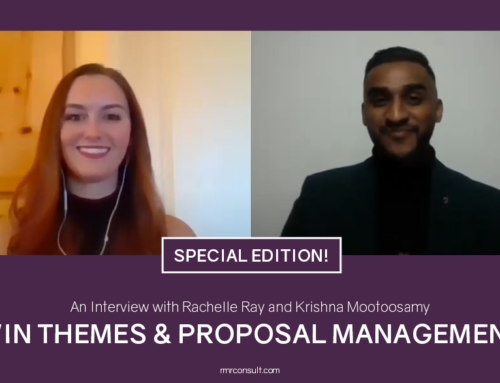I spend a lot of time here on the blog talking about client challenges and motivations. Understanding these is integral to putting together a strong win theme and writing a proactive proposal. If the RFP dropped before you knew about it or you haven’t had enough time to build a relationship with a client, you might struggle to articulate what’s motivating them and driving the project. Creating a client profile can help with this.
What is a client profile?
A client profile gives you a snapshot of the most important elements of the client as an individual or their organization. It can be high level, covering basic mission/vision and values. It can be an in-depth brief on individual stakeholders, or it can be comprehensive, covering local culture, legislature, or anything that might influence the project.
The level of depth for your client profile will depend on the time you have to create it and how much information you need to identify challenges for your win theme. It will also depend on the information available to you. In some instances, you’ll find pages upon pages of content, but in others, you’ll find almost nothing. In either case, remember to focus on the people behind the project. People drive projects. People have challenges. Projects don’t. So, you’re more likely to find key motivations by studying the people than you are the project.
As you seek to understand the client, keep in mind the basic ideas of building a target market profile like demographics and psychographics.
Where to look for content for your client profile.
- Their website
- News outlets
- Community blogs
- Social Media
- Funding applications
- Your network (ask around, someone you know probably knows someone or something useful)
Start with the basics
The Internet is a beautiful thing. Most client organizations have websites with their basic information – these serve as a great starting point for building your client profile. You can often find a clients’ mission, vision, values, and goals on their website. These can give you a basic idea of general motivations and help you to focus on project-specific motivations. For example, suppose the client organization is a school district, and its mission is to provide an equal education for all students. In that case, you might home in on themes of equality and accessibility and see if those fit the project profile.
Another thing to look for on client websites is planning documents. Many local governments and education institutions have comprehensive plans or campus master plans. These are often even posted online. If you’re really lucky, you can find community information sessions with presentations and notes on the development of these plans. Digging into all of this information will give you a solid understanding of the strategic reasons behind projects. For example, a campus master plan might identify a university’s commitment to more flexible, higher-tech learning spaces. A city’s comprehensive plan might focus on carbon neutrality. What can you do with that information? How can your firm align with those goals?
The final thing you’ll want to look for on a client’s website is the people. Who are the key stakeholders or decision-makers? Do they have a board of directors? A project steering committee? Take note of these individuals in your client profile; we’ll come back to that information in a minute.
Check the news
We want to learn as much as we can about a project before we write our proposal. Ideally, you have a business development team out working with the client to get this information firsthand. Of course, not all of us have that luxury, and that’s okay! There are other ways to get the information we need, and one of those is to check the news.
Admittedly, not all projects are newsworthy. Large projects, or projects that will significantly impact a community in some way, often receive news coverage. There may be public meetings where the client seeks community input on various options for a project (anything from programming to siting). There might also be news coverage on funding; client organizations often want the public to see the need for their projects before bond elections, for instance.
Newspapers and news stations aren’t the only sources for news, either. Check client blogs (if they maintain one) or business journals in the area. Local publications or community newspapers and bulletins often keep tabs on new developments.
Track the money
Another way to build information for your client profile is to track the money. Publicly funded projects usually leave paper trails in the form of applications for funding or presentations for funding. The client generally has to establish a pressing need for the project to secure the funding, so this is a great place to identify pain points.
A great, albeit unique, example of using the ‘track the money’ method came from a federal organization several years ago. The Bureau of Indian Affairs and the Bureau of Indian Education had money to fund ten major school projects across the United States. Of course, there are far more than ten tribes in the country and far, far more than ten schools that could have benefitted from that money. The BIA/BIE asked that schools submit applications for funding. About twenty of those applicants were invited to give presentations. All of the applications and presentations were made available to the public. Anyone could have gone through those documents and made a note of the critical conditions, concerns for student and staff safety and well-being, and the key individuals involved in the application process. All it took was a little bit of creative searching (and a lot of resolve to read about the heartbreaking conditions at these schools – but that’s another issue.)
Get to know the people
The final, and perhaps most important, part of your client profile is the people. As I’ve mentioned before, people have problems and personal motivations; projects don’t. Before we dig into this last section, I want to put a disclaimer upfront: please don’t pester, bother, harass, or stalk anyone online.
What we want to do is learn more about our future client partners. If they have a LinkedIn presence, start there. See what content they like and share. Have they complained about anything recently, like how slow a process is or how frustrating over-crowding in schools is? Take note of these things and translate them into hot button issues that you can respond to in your proposal. Another note – I prefer to keep my client profiling to professional networks like LinkedIn or even Twitter. Instagram and Facebook feel too private, and I have never gained any meaningful insights from those platforms. Again, please respect the privacy of your client.
You can also search the web for these individuals. They might have been profiled or interviewed by a news outlet, and you can search for insights in those articles. I once found a podcast interviewing the director of a client organization and was able to get such a strong sense of her personality that we were able to tailor our proposal to it through carefully selected visuals and a few well-chosen keywords.
Creating a client profile might feel tedious, but if you’re struggling to develop a win theme or wrap your head around a proposal, it’s a great place to start. At the very least, give yourself half an hour to run the client, the project, or the stakeholders, through a quick search. You might be surprised at the insights you turn up.






Leave A Comment